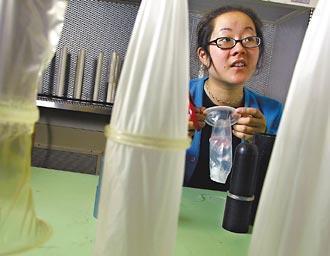HOW CAN HERE AND THERE exist at the same time on the same planet?
There, in homes without medicine or even gloves, thousands of young mothers are dying, leaving thousands more daughters alone and at risk.
Here, in a boxy barn-red building at the base of Seattle's Ballard Bridge, global health workers are searching for solutions. Here, in a high-tech tinkerer's workshop in the basement, we chat with Lisa Tam, a thoughtful thermoplastics whiz.
 |
| BETTY UDESEN / THE SEATTLE TIMES |
| The search for solutions has become a race against time and culture. At Seattle-based PATH (Program for Appropriate Technology in Health), Lisa Tam is helping to build a better female condom with feedback from women around the world. |
|
 |
 |
Her quest: to build a better female condom.
"We hear all these horror stories about women whose husbands refuse to wear male condoms but go out and use prostitutes and it makes you go, ĎOh boy, we really gotta do something.' "
Lisa is 28, with four silver hoops in each ear, a dragon stippled on her back, a degree in manufacturing engineering technology and the delicate hand skills of the jewelry maker and taxidermist she once was. She works at PATH, the Program for Appropriate Technology in Health.
For 27 years, the Seattle-based nonprofit has been devising ways to improve the health of women and children in developing countries. Among PATH initiatives: a defanger to remove needles from syringes; rapid tests for malaria, syphilis and HIV; a temperature sensor for vaccines; a solar-powered vacuum-insulated freezer; a pre-filled one-use syringe; massive efforts to vaccinate against Hepatitis B and meningitis; vitamin-enhanced rice, and ways to get vaccines to children in the world's 74 poorest countries.
Since 1995, PATH's work has been turbocharged with more than $285 million from the Gates Foundation, including $5 million to continue work on the female condom, a one-size-fits-most silicone diaphragm and a microbicidal gel.
"When you die, you die. ... Thatís it. You donít come back."
— AMAI CATY, RUTHíS MOTHER |

|
 |
 |
 |
 |
 |
Sparing Martha's generation from AIDS will require a liaison between science and business.
Commercial companies usually shy away from such research because there is too little economic incentive, too much upfront risk. So while Big Pharma chases easy money to be made from a second-generation Claritin or Viagra, nonprofits like PATH step in, funded by governments, gifts and grants. PATH tries to kick-start the market structure by developing a first-generation product and eventually partnering with the private sector to manufacture and distribute it.
Lisa came to the female condom project after stints stuffing dead animals and fabricating fiberglass sports-car chassis. The daughter of two scientists, she grew up in Seattle's Ravenna neighborhood and studied biology and engineering at Western Washington University. She wanted "to do more than making a company a lot of money."
"I'd always wanted to invent something that would help people," she says. "Not anything earthshaking, but something."
In PATH's basement workshop, Lisa works at a simple wooden table with simple tools: soldering irons, wire brushes, screwdrivers, PVC tubing, X-ACTO knives, dremmel drills, wooden mallets, a hand torch, calipers, spray bottles, a yellow 1/2-inch tape measure from Ace Hardware. Radiohead and Kaito crank on the CD. There's a laminar air-flow hood and several long-limbed machines wired to computers, including one that simulates intercourse with a pneumatic cylinder.
Lisa takes 57 seconds to construct a basic female condom. She cuts a sheet of transparent urethane from what looks like a giant roll of Saran Wrap. The urethane is one one-thousandth of an inch thick, silkier and thinner than the latex of male condoms and less vulnerable to hot climates. She folds the urethane, tops it with a Teflon template about the shape and size of a baby bottle and traces the form with a heated knife, simultaneously cutting and welding the plastic sheet into a pouch. She slides the pouch into a PVC cylinder about the size of a tennis-ball can, welds a plastic ring to the top and files away rough edges with a tiny drill. Voila!
Team coordinator Joanie Robertson, a diehard bicycle commuter, will pedal the condoms to Harborview Medical Center to be sterilized before they are sent around the world to be tested by volunteers.
Feedback has been enthusiastic and, at times, startling. In some countries, women wanted to wear the condoms while walking around during the day — in case of rape.